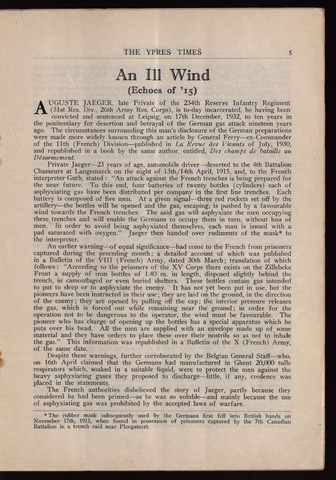THË VPRES TIMES
(Echoes of '15)
5
AUGUSTE JAEGER, late Private of the 234th Reserve Infantry Regiment
(51 st Res. Div., 26th Army Res. Corps), is to-day incarcerated, he having been
convicted and sentenced at Leipsig, on 17th December, 1932, to ten years in
the penitentiary for desertion and betrayal of the German gas attack nineteen years
ago. The circumstances surrounding this man's disclosure of the German preparations
were made more widely known through an article by General Ferryex-Commander
of the 11th (French) Divisionpublished in La Revue des Vivants of July, 1930,
and republished in a book by the same author, entitled, Des champs de bataille aa
Désarmement.
Private Jaeger23 years of age, automobile driverdeserted to the 4th Battalion
Chasseurs at Langemarck on the night of 13th/14th April, 1915, and, to the French
interpreter Guth, stated "An attack against the French trenches is being prepared for
the near future. To this end, four batteries of twenty bottles (cylinders) each of
asphyxiating gas have been distributed per company in the first line trenches. Each
battery is composed of five men. At a given signalthree red rockets set off by the
artillerythe bottles will be opened and the gas, escaping, is pushed by a favourable
wind towards the French trenches. The said gas will asphyxiate the men occupying
these trenches and will enable the Germans to occupy them in turn, without loss of
men. In order to avoid being asphyxiated themselves, each man is issued with a
pad saturated with oxygen." Jaeger then handed over rudiments of the mask* to
the interpreter.
An earlier warningof equal significancehad come to the French from prisoners
captured during the preceding montha detailed account of which was published
in a Bulletin of the VIII (French) Army, dated 30th March; translation of which
follows "According to the prisoners of the XV Corps there exists on the Zillebeke
Front a supply of iron bottles of 1.40 m. in length, disposed slightly behind the
trench, in camouflaged or even buried shelters. These bottles contain gas intended
to put to sleep or to asphyxiate the enemy. It has not yet been put in use, but the
pioneers have been instructed in their usethey are laid on the ground, in the direction
of the enemythey are opened by pulling off the capthe interior pressure releases
the gas, which is forced out while remaining near the groundin order for the
operation not to be dangerous to the operator, the wind must be favourable. The
pioneer who has charge of opening up the bottles has a special apparatus which he
puts over his head. All the men are supplied with an envelope made up of some
material and they have orders to place these over their nostrils so as not to inhale
the gas." This information was republished in a Bulletin of the X (French) Army,
of the same date.
Despite these warnings, further corroborated by the Belgian General Staffwho,
on 16th April claimed that the Germans had manufactured in Ghent 20,000 tulle
respirators which, soaked in a suitable liquid, were to protect the men against the
heavy asphyxiating gases they proposed to dischargelittle, if any, credence was
placed in the statements.
The French authorities disbelieved the story of Jaeger, partly because they
considered he had been primedas he was so volubleand mainly because the use
of asphyxiating gas was prohibited by the accepted laws of warfare.
The rubber mask subsequently used by the Germans first fell into British hands on
November 17th, 1915, when found in possession of prisoners captured by the 7th Canadian
Battalion in a trench raid near Ploegsteert.

